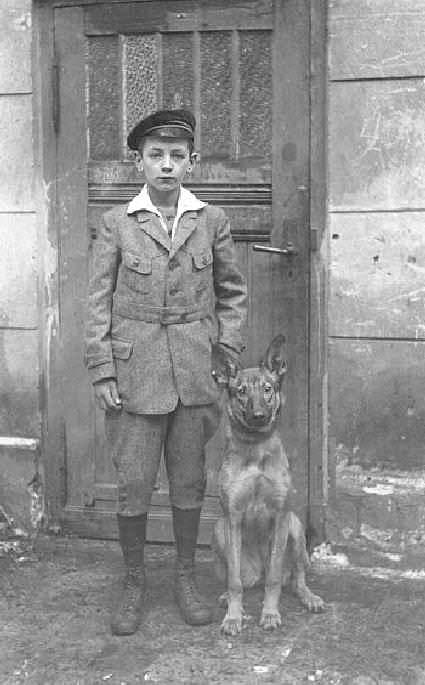
Figure 1.--This German boy wears a knickers suit with a military peaked cap. This is probably what he weore to school. The image is undated, but we believe was taken after World War I, about 1920.


Figure 1.--This German boy wears a knickers suit with a military peaked cap. This is probably what he weore to school. The image is undated, but we believe was taken after World War I, about 1920. |
Many European boys in the late-19th and early-20 cenury wore peaked military caps. We have little chronological information, but believe these or similar styles were widely worn by Prussian school boys in the late 19th century, We are less sure about other German states. They appear to have become popular throughout Germany after unification in 1870. We have noted these caps especially in Germany, but they appaer to have been worn to a lesser extent in other European countries as well. There were several differnt styles. These were not part of uniforms, but rather worn with the boys ordinary clothes. Few German schools required actual uniforms. Some boys even wore them with sailor suits. They were worn both as part of a standadized school uniform and as a style selected individually. We have also noted them worn with sailor suits. We have not noted them being worn in Europe and Germany after the 1920s. They were adopted by Japanese schools and are still widely worn in Japan today, mostly by boys in secondary school. Before World War II Japanese primary school boys also wore these caps, but after the War they became mostly wore by boys in secondary schools.
Boys in many European countries wore peaked militay caps durig th 19th cenyury. English boys wore them during te early Victorian era. Many European boys in the late-19th and early-20 cenury wore peaked military caps. They sem to have been especially popular in Germany. We have little chronological information, but believe these or similar styles were widely worn by Prussian school boys in the late 19th century, We are less sure about other German states. Even after unificatin in 1871, the different German states (Landen) mauntained control over education. These caps appear to have become popular throughout Germany after unification in 1870. We have noted these caps especially in Germany, but they appaer to have been worn to a lesser extent in other European countries as well, although we still have little information in this. These caps were adopted by Japanese schools and are still widely worn in Japan today, mostly by boys in secondary school. Before World War II Japanese primary school boys also wore these caps, but after the War they became mostly wore by boys in secondary schools.
HBC at this time has only limited chronological information. The earliest images we have show boys wearing thse peaked caps in the 1860s. We believe, however, that they were worn in the 1850s or even earlier. German images from the 1870s show boys wearing them. They ppar to have been very commonly worn, but not as part of a uniform. Many of the images we note are German, but we believe they were worn in other European countries as well. They were adopted by the Japanese for school uniforms, but we are not sure precisely when. We note manu German boys ering them in the late 19th centutry. We also note them after the turn of the 20th century, but less commonly. We have not noted them being worn in Europe and Germany after the 1920s. After this these caps were mostly worn only in Japan. Japanese boys still wear them as part of a uniform in the 2000s.
There were several differnt styles. The standard featur was a leather brim, sometimes patent leather and well shined. The principal difference was the cloth part. Some caps were cilindrical rather like a pill-box cap. These might have stripe of different colors and width. There were also soft caps which varied in stiffness and height. Some look like modern military campaign caps with a very stiff front that rose at the brim and a stiff rounded form aover the crown. More common ws a rather formless top. We have noted both white and dark caps. We are unsure about the color of the dark caps, presumably black and blue. The brim was always black. There were also variations in the base of the cap.
These vaps were not normally part of uniforms, but rather worn with the boys ordinary clothes. Few German schools required actual uniforms. There were a few military schools where they were worn as part of the uniforms. Much more common, however, was to wear these caps with the boy's ordinary clothes.
Some boys even wore them with sailor suits. They were worn both as part of a standadized school uniform and as a style selected individually. The most common outfit appears to have been various styles of suits. We have also noted them worn with sailor suits. In fact many school portraits show this military style cap as being more common than sailor caps and hats with sailor suits. This was at least the case in Germany. We are les sure about other countries.
Related Chronolgy Pages in the Boys' Historical Web Site
[Main Chronology Page]
[The 1900s]
[The 1910s]
[The 1920s]
[The 1930s]
[The 1940s]
[The 1950s]
[The 1960s]
[The 1970s]
[The 1980s]
[The 1990s]
[The 2000s]
Navigate the Relate Boys Historical Clothing Uniform Garment Pages
[Main garment page]
[Blazers]
[Bookbag]
[Headwear]
[Caps]
[Hose]
[Kilts]
[Pants]
[Shirts]
[Sandals]
[Smocks
[Suits]
[Sweaters]
[Ties]
Navigate the Boys' Historical Clothing Web Page
[Introduction]
[Activities]
[Biographies]
[Chronology]
[Clothing styles]
[Countries]
[Bibliographies]
[Contributions]
[FAQs]
[Italain glossary]
[Satellite sites]
[Tools]
[Boys' Clothing Home]
